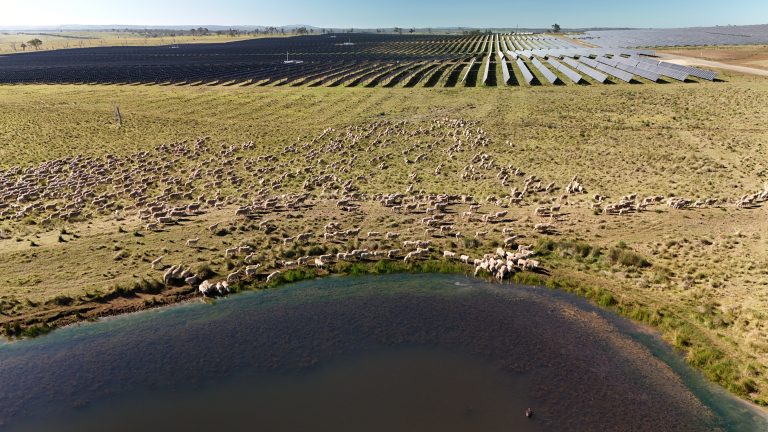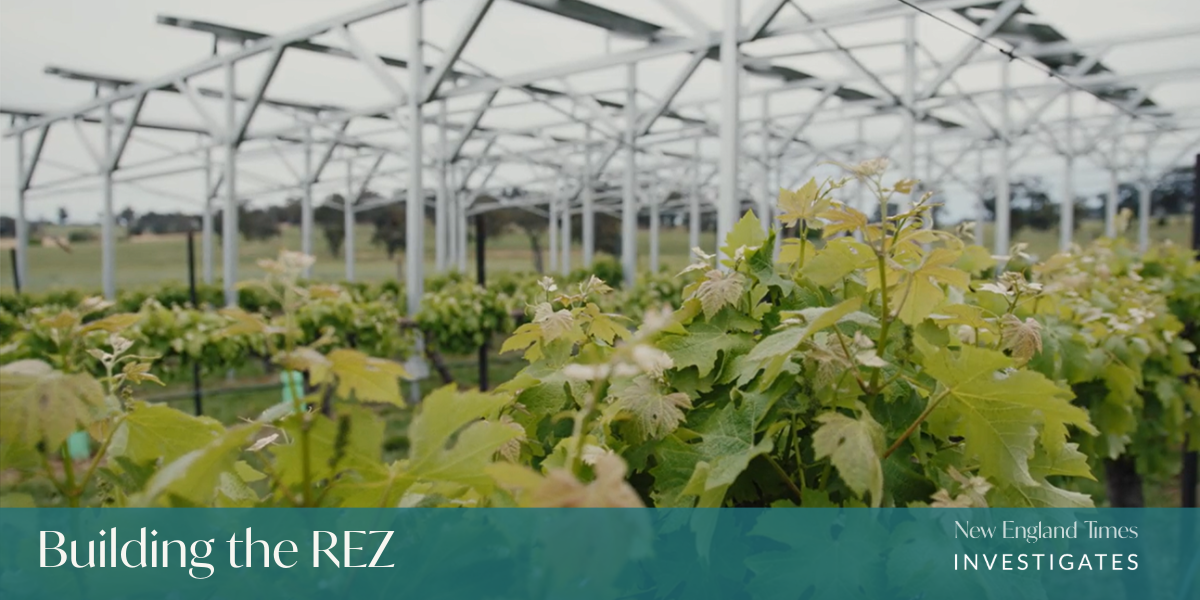This story is part of our feature series on Building the REZ in the New England.
Read more from this series here.
Agrivoltaics is emerging as an important compromise for the land use conflict between farmers and solar energy developments in Australia.
Research into agrivoltaics, which refers to co-locating agricultural activities with large scale solar projects, has ramped up across all states and more developers are working alongside farmers to combine food and fibre production with renewable energy.
New England leads the way
In the New England Renewable Energy Zone (REZ), the first stage of ACEN Australia’s 720 MW New England Solar Farm is sharing paddocks with more than 6,000 sheep. The mob of merino and crossbred sheep graze for six weeks at a time under about one million panels and early results are promising for the mutual benefits of agrivoltaics.
ACEN Australia says the company’s first operational agrivoltaics project in Australia is proving to be a successful example of how solar energy generation and sheep grazing can co-exist.
Through its agrivoltaics-based program, “Solar Gulayan”, five of ACEN’s solar farms in the Philippines are combined with horticultural production.
“All of ACEN Australia’s wind and solar projects are being developed so that our projects work in harmony with the existing and planned future use of the land,” a spokesperson said.
“We work with our host landholders to understand how the land is used and what they are seeking to do into the future. The discussions with host landowners inform planning and designs so that livestock grazing can be incorporated into the project and how infrastructure we need to build may be best placed to benefit the host landowners.”
“The initial success of solar grazing at New England Solar is bringing further support from landholders for our other projects.”
Securing a farming future for generations
Uralla farmers and brothers Simon and Cameron Wood are involved in ACEN’s solar grazing project. They have been utilisiing solar panel paddocks as part of their rotational grazing program for up to 1600 sheep on their 1620-hectare family farm ‘Dog Trap’ since October last year.
“There has been abundance of feed in those paddocks all year round, but it has been a good year with winter rainfall. It does appear that clover growth is improved under the panels, particularly during the winter months,” Simon said.
“There is certainly no detrimental impact to pastures at this stage. The test will come in dry year, but my gut tells me it will hold on longer.”
“Weed management in those pastures is the responsibility of ACEN, and they have been a really good job of it.”

“You can only have sheep underneath the panels. Cattle can cause too much damage rubbing on them and apparently, they tried goats somewhere and they ended up sleeping on top of the panels.”
A fifth generation farmer, Simon Wood says hosting a solar project has made the handing over of the farm to the next generation “more of a reality”.
“Being able to expand in agriculture in this area is difficult and often unviable based just on wool, lamb and beef production. This enables us to drought proof the farm, have the confidence to invest in the farm and look to the future.”
ACEN Australia said it is pursuing opportunities for formal research into pasture and stock management, in partnership with academic institutions.
“It is still early days at New England Solar. There will always be lessons to learn and further refinement of pasture and stock management,” ACEN’s spokesperson said.
Research into cropping under solar panels promising
Australia is playing catchup in the agrivoltaics field, including assessing the opportunities and challenges of using sunshine twice for crop production. Research gaps, technical and economic impediments, poor planning and a lack of clear policy guidance at development stage have hindered uptake.
Solar grazing studies like that at ACEN’s New England project have taken precedence, but the University of Melbourne and others are now investigating horticultural crops grown beneath solar panels in Australian conditions.
University of Melbourne researchers have started exploring how agrivoltaics could benefit viticulture and horticulture production in a new project titled Agrivoltaics: A Win-Win for Farmers?
Funded by AgriFutures, the project comprises a review of existing studies here and overseas, engagement with industry, an agrivoltaics pilot study set in the university’s vineyard.
Dr Sabine Tausz-Posch, Senior Lecturer in Agricultural Food Sciences from the University of Melbourne, said the pilot agrivoltaics system got up and running in August.
“We are now testing how grape production performs in combination with 20 Kilowatt solar system on a small section of the university’s Sauvignon blanc vinyeard. That includes monitoring leaf temperatures, photosynthesis, water use and eventually yield and quality comparisons.”
Dr Tausz-Posch said the solar panels were designed to provide around an extra 27 per cent shade for the vines.
“We are also comparing the energy efficiency of the agrivoltaics system to a ground mounted solar system also located in the vineyard.
“As we move forward, we will look at using the renewable energy that is generated for in the vineyard or to provide energy for electric vehicle charging stations.”
Dr Tausz-Posch said further funding through the Agrifuture’s Innovation grants program will expand agrivoltaics research into other states.
“I think there are some horticultural crops such as berries and leafy greens that will benefit from being combined with solar panels.”
“A study conducted in Arizona, for example, found that the production of cherry tomatoes doubled and that of chiltepin peppers tripled under the solar panel installation.”
“It can be real win-win for horticultural crops. Some crop production systems are quite energy intensive, and the solar powered electricity can be used to power irrigation and temperature control systems.”
“It also means that you are not taking away prime agricultural land for electricity production.”
Growing conservoltaics in the New England
Momentum is also building to incorporate conservoltaics into planning guidelines for solar developments in the New England REZ thanks to the efforts of the Community Power Agency (CPA).
CPA’s New England Regional Coordinator, Heidi McElnea, has been busy liaising with developers to inspire opportunities to combine solar energy production and biodiversity conservation.
CPA formed in 2011 with a focus on advocating for community investment models for renewable energy. It became a cooperative in 2014 and has since expanded into working with large scale developers to improve the social and economic outcomes of renewable energy development for communities and landholders.
“There has definitely been a gap in supporting communities and landholders through this change and to get the regional economic development benefits that could come of this,” Heidi said.
Heidi said wider adoption of conservoltaics and agrivoltaics would help appease concerns about the landscape transformation that is happening on generational farms due to large scale solar projects.
“We would like see planning policy introduced that requires developers to show that thier projects are nature positive, and we are advocating for onsite restoration works to be planned for.”
“Some developers are progressive and looking into what kinds of grass and groundcover species are best for encouraging pollinators, how soil carbon levels may be improved and adjusting plans based on habitat impact.
CPA released a Guide to Better Biodiversity on Solar Farms in May, with support from the Foundation for Rural & Regional Renewal’s Strengthening Rural Communities Program. Hiedi provides the guide to developers to help open the door on conservations about incorporating improved biodiversity outcomes.
The Guide include strategies and case-studies to improve conservation planning and implementation on solar farms, with a focus on plant and animal communities that are endemic to the Northern Tablelands and Nandewar bioregions.
Top image: viticulture under solar panels (Greenwood Solutions; University of Melbourne)
This story is supported by grant funding from the Local Independent News Association (LINA) and the Meta Australian News Fund administered by the Walkley Foundation.
Like what you’re reading? Support The New England Times by making a small contribution today and help us keep delivering local news paywall-free. Support now

